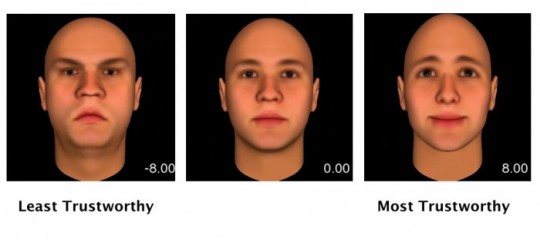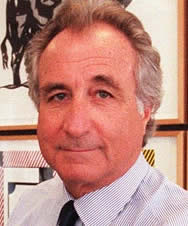Unconscious Trust Formed in Milliseconds

We’ve known that our brains form first impressions of both people and things very, very quickly.
A 2006 study showed that a mere 50 milliseconds were enough to form an opinion about a website. More recently, researchers have discovered that our brains form an impression of faces even when the exposure time is so short we’re not consciously aware we saw them.
The scientists found that our amygdala, an area of the brain associated with emotion and decision-making, makes a judgment about the trustworthiness of a face after just 33 milliseconds of exposure. The subjects didn’t recall seeing faces, but their amygdalas reacted differently depending on the face details.
Trustworthy Faces
A few years ago, Princeton scientists Nikolaas Oosterhof and Alexander Todorov found that certain facial characteristics connote trust. In particular, mouth and eyebrow shapes are important. Angry-looking eyebrows and downturned mouths are untrustworthy. More trustworthy faces have slightly surprised looking eyebrows and a smiling “u” shape mouth.

That research, too, showed that very little time was needed to form an impression of the face’s trustworthiness.
Undeserved Trust
Did you ever wonder how some people seem to engender trust, even when it’s not deserved? Con artists, swindlers, and others of that ilk are often far more successful at, for example, getting money from investors than legitimate entrepreneurs.

But it seems likely that in some cases we trust con artists because they look trustworthy. Note how Bernie Madoff, who bilked investors for billions, exemplifies the facial characteristics for trust (other than the eyebrow asymmetry).
Building Trust
Most of us will be stuck with our own faces forever, and I don’t recommend plastic surgery as a way to seem more trustworthy. But, there are a few things we can do to help build trust quickly.
First Impressions. There is a wealth of research showing that first impressions are formed in much less than a second, and are often quite durable. A first impression can even prevail over later objective evidence that conflicts with that impression. (See First Impressions: Incredibly Quick To Form, Slow To Change.) So, be sure that whatever your customer sees first supports the impression you want to form. Even a few seconds later may be too late.
Recruiting. Our human reliance on facial features is a two-edged sword. It can be our undoing if we are hiring an accountant, for example, and fail to check her background because she seemed so open and trustworthy in the interview. The most common lament of a business owner who has been a victim of embezzlement is that the perpetrator “seemed totally trustworthy” – facial appearance may be one part of that.
On the other hand, if we are recruiting for a customer-contact position involving trust like, for example, a financial advisor, a trustworthy appearance could provide an edge with customers. Chances are that we already unconsciously factor this in when we compare candidates, but it’s good to have some objective metrics.
Of course, a trustworthy face is one small element of establishing trust with a customer. Communication skill, follow-through on commitments, knowledge of the field, and many other factors will affect the customer’s overall trust in the individual and company.

Facial Expression. We can’t change our basic face, but we can change its expression. Real-estate mogul and politician Donald Trump exemplifies this in a composite photo from CNN.com.

Spend a little mirror-time adopting a small smile and upturned eyebrows, and you’ll seem more trustworthy. (And, since artificially-forced facial expressions have been shown to affect our emotional state, maybe you’ll even be more trustworthy.)
Imagery. While trying to use facial characteristics in recruiting staff is iffy, and changing our basic facial appearance is difficult or impossible, one area that can be controlled quite readily is the imagery we use in advertising and on websites.
By choosing a face image that has strong trust characteristics we will increase the trust in our company or brand.
Testimonials are one area where trust can help credibility.
For a while, Google was using picture testimonials for its Adwords product. The U.S. ad image featured a man who looked like the embodiment of the “most trustworthy” image above. I couldn’t locate that image, but I did find one from the U.K.:

Here’s another testimonial example from Adroll – the left photo has particularly strong facial trust characteristics.

Though they provide no statistics, the Adroll post notes that clicks generated from these testimonial images converted at a higher rate and were of higher quality.
Similarly, whether you are including a photo of your CEO or a customer service rep, try to find (or create) an image that embodies facial trust characteristics.
Beyond Faces
While face-based trust is important, it is just one element of a first impression. The website research showed that our brains rapidly and unconsciously integrate a variety of visual information to determine our liking for a site.
Therefore, you should be sure that all elements of your first impression support your desired image. An in-person impression may be altered by clothing, neatness, demeanor, smiling, environment, and more. An ad or website will have many other aspects of visual appearance that will affect both non-conscious and conscious impressions. Elements like trust symbols, colors, design quality, and so on, can all be important.
Look trustworthy, but pay attention to the rest of the package too.
